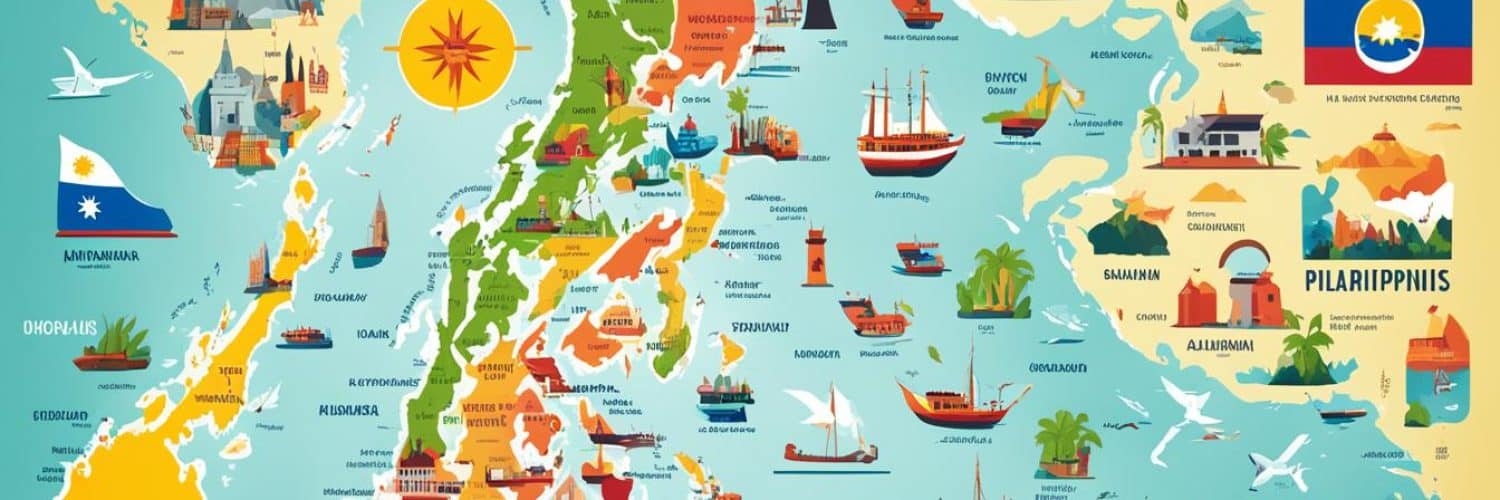Did you know that the Philippines is home to a vast array of languages? From Filipino to regional dialects, the Philippine linguistic diversity is truly remarkable. Have you ever wondered why there are so many dialects and how they differ from one another?
Join us as we delve into the fascinating world of language in the Philippines. From major dialects to historical influences, we will uncover the complexities and nuances of the Philippine linguistic landscape. Discover the rich tapestry of regional languages that contribute to the country’s cultural heritage, and gain a deeper understanding of the unique speech variations found throughout the archipelago.
Get ready to explore the diverse and vibrant world of different dialects in the Philippines. Are you ready to embark on this linguistic journey?
Key Takeaways:
- The Philippines is known for its rich linguistic diversity, with around 130 to 195 languages spoken throughout the country.
- Tagalog, Cebuano, Ilocano, and Hiligaynon are some of the major dialects in the Philippines.
- Filipino and English are the official languages of the Philippines, while regional languages hold auxiliary status in their respective regions.
- The linguistic landscape of the Philippines has been shaped by its colonial history, with Spanish and English playing significant roles.
- Filipino is the national language of the Philippines, based on Tagalog, with over 28 million native speakers.
Languages Spoken in the Philippines
The Philippines is a country known for its linguistic diversity. In addition to the official languages of Filipino and English, the country recognizes 19 regional languages. These regional languages are spoken in specific areas and contribute to the rich cultural tapestry of the Philippines.
Some of the regional languages spoken in the Philippines include:
- Aklanon
- Cebuano
- Chavacano
- Hiligaynon
- Ibanag
- Ilocano
- Ivatan
- Kapampangan
- Kinaray-a
- Maguindanao
- Maranao
- Pangasinan
- Sambal
- Surigaonon
- Tagalog
- Tausūg
- Waray
- Yakan
Each regional language has its own unique characteristics and is an integral part of the local culture and identity. These languages reflect the diverse heritage and history of the different regions in the Philippines.
Regional Language Table
| Regional Language | Location | Number of Speakers |
|---|---|---|
| Aklanon | Aklan | Approximately 335,000 |
| Cebuano | Cebu, Bohol, and other parts of Visayas and Mindanao | Approximately 21 million |
| Chavacano | Zamboanga City and other parts of Mindanao | Approximately 600,000 |
| Hiligaynon | Western Visayas, Antique, Aklan, and parts of Mindanao | Approximately 9 million |
| Ibanag | Cagayan Valley Region | Approximately 1 million |
| Ilocano | Northern Luzon | Approximately 8 million |
| Ivatan | Batanes | Approximately 10,000 |
| Kapampangan | Pampanga and parts of Central Luzon | Approximately 2.5 million |
| Kinaray-a | Antique, Iloilo, and other parts of Western Visayas | Approximately 1.5 million |
| Maguindanao | Maguindanao, Cotabato, and other parts of Mindanao | Approximately 1.8 million |
| Maranao | Lanao del Sur, Lanao del Norte, and other parts of Mindanao | Approximately 1.4 million |
| Pangasinan | Pangasinan and parts of Ilocos Region | Approximately 2.5 million |
| Sambal | Zambales, Tarlac, and parts of Central Luzon | Approximately 250,000 |
| Surigaonon | Surigao del Norte, Surigao del Sur, and other parts of Mindanao | Approximately 800,000 |
| Tagalog | Central Luzon, Metro Manila, CALABARZON, and parts of Mindanao | Approximately 23 million |
| Tausūg | Sulu, Tawi-Tawi, and other parts of Mindanao | Approximately 1.2 million |
| Waray | Leyte, Samar, Biliran, and parts of Eastern Visayas | Approximately 3 million |
| Yakan | Basilan and other parts of Mindanao | Approximately 52,000 |
Historical Background of Philippine Languages
The linguistic landscape of the Philippines has been profoundly influenced by its colonial history, which has shaped the development and prominence of various languages in the country.
During the Spanish colonial rule, which lasted for more than three centuries, Spanish became the official language of the Philippines. This period of Spanish influence significantly impacted the language, culture, and society of the archipelago.
Following the Spanish colonial era, the Philippines came under American occupation. As part of their efforts to modernize the country, English became the medium of instruction in schools and the lingua franca for communication.
“The mastery of English became a prerequisite for education, employment, and social mobility,” said linguist Dr. Jose G. Perez in his research on Philippine languages.
Tagalog, spoken primarily in the regions around Manila, gained prominence during this time and was declared the official language in the 1937 constitution. It served as the foundation for the development of Filipino, a standardized version of Tagalog, which became the national language of the Philippines in 1987.
Today, Filipino and English are recognized as the official languages of the Philippines. While Filipino, based on Tagalog, is the national language, English continues to play a vital role in education, business, and government.
In addition to Filipino and English, regional languages hold auxiliary status and are widely spoken throughout the country. These regional languages embody the linguistic diversity and cultural richness of different communities across the Philippines.
Language Influences and Lingua Franca
Spanish colonial rule left a lasting impact on the Philippine languages, particularly in terms of vocabulary. Many Spanish words and phrases were assimilated into different Philippine languages, resulting in a significant number of loanwords.
Moreover, English’s status as the lingua franca during American occupation greatly influenced the Filipino lexicon. English loanwords are now commonly used and integrated into daily conversation.
“The Philippines is something of a dream world for English loanwords,” wrote English linguist David Crystal, emphasizing the widespread use and influence of English-derived vocabulary in the Philippines.
Regional languages, on the other hand, continue to thrive among their respective communities, representing the linguistic diversity and preserving the unique heritage of different regions throughout the Philippines.
| Language | Origin | Significance |
|---|---|---|
| Tagalog/Filipino | Austronesian (Malayo-Polynesian) | National language, widely spoken in Luzon and Manila |
| Visayan languages (Cebuano) | Austronesian (Malayo-Polynesian) | Spoken in the Visayas and Mindanao regions, serves as a lingua franca |
| Ilocano | Austronesian (Malayo-Polynesian) | Prevalent in northern Luzon, primarily used in the Ilocano-speaking population |
| Tausug | Mixed Austronesian (Malayo-Polynesian) and Arabic | Spoken in the Sulu province and eastern Sabah, Malaysia, influenced by Arabic loanwords |
| Hiligaynon | Austronesian (Malayo-Polynesian) | Mainly spoken in Western Visayas, Antique, Aklan, and North Cotabato |
The multi-lingual nature of the Philippines reflects its diverse cultural heritage and fosters a sense of unity among its people, despite the linguistic variations across different regions.
Filipino: The National Language
Filipino, the national language of the Philippines, is derived from Tagalog, the language spoken in the capital city of Manila. As part of the Austronesian language family, Filipino has deep roots within the indigenous languages of the archipelago. It is estimated that Filipino has over 28 million native speakers.
One of the unique aspects of Filipino is its development through language influence. Over the years, Filipino has absorbed vocabulary from various languages, resulting in a diverse range of loanwords. Spanish, English, Arabic, and regional languages have all contributed to the rich tapestry of Filipino vocabulary.
As a result of this linguistic evolution, Filipino has become a vibrant language that reflects the cultural and historical influences of the Philippines. It encompasses not only the everyday expressions and idioms of its native speakers but also encapsulates the nation’s multifaceted heritage.
To give you a better understanding of the loanwords that have shaped Filipino, here is a table showcasing some examples:
| Language Influence | Loanword | Meaning |
|---|---|---|
| Spanish | Pamilya | Family |
| English | Kompyuter | Computer |
| Arabic | Suklay | Hairbrush |
| Regional Languages | Sarong | Skirt |
This image visually represents the beauty and diversity of the Filipino language, symbolizing the cultural richness that Filipino encompasses. It reminds us of the importance of language as a vital component in expressing the identity and heritage of a nation.
English in the Philippines
English holds a significant position in the Philippines as an official language. Introduced during the era of American colonial rule, English remains a crucial language in education, business, and government. With approximately 40 million English speakers, the Philippines possesses one of the largest English-speaking populations globally.
English’s official status opens numerous opportunities for Filipinos in various sectors, including education and business. Proficiency in English enables individuals to access a broader range of resources, communicate effectively with international counterparts, and pursue global opportunities. It serves as a gateway to higher education, as many tertiary institutions conduct courses in English.
The influence of the English language in the Philippines also extends to the business sector. English-speaking skills are highly valued in industries such as outsourcing, customer service, and tourism. Proficiency in English enables Filipinos to cater to the needs of a global client base, fostering international collaborations and economic growth.
“English proficiency is essential in the modern globalized world. The ability to communicate fluently in English allows Filipinos to excel in various fields, making them competitive on the international stage.”
English has evolved into a lingua franca, enabling effective communication among diverse linguistic groups within the Philippines. While Filipino and regional languages hold their significance, English bridges the linguistic divide, fostering unity and promoting effective communication on a national level.
Additionally, English proficiency facilitates cultural exchange and understanding, as Filipinos are exposed to a wide range of English-language literature, media, and entertainment. It serves as a bridge between different cultures and ideologies, facilitating global connections and facilitating the development of a multi-cultural society.
The Impact of American Colonial Rule
English’s prominence in the Philippines can be traced back to the American colonial period, lasting from 1898 to 1946. The United States introduced English as the medium of instruction and governance, leaving a lasting imprint on the country’s linguistic landscape.
During this era, English became the language of education, leading to the establishment of English-speaking schools and the wide adoption of English as a second language. The American influence brought formal English education to the Philippines, shaping the language’s usage and prevalence within the country.
The American occupation also accelerated the spread of English through media, with English-language publications, radio programs, and movies becoming popular. This exposure to American English further contributed to its widespread usage and comprehension among Filipinos.
English in Education and Business
In the Philippines, English plays a vital role in education. English is taught as a subject in schools, ensuring that students develop proficiency in reading, writing, and speaking English. Many tertiary institutions also use English as the medium of instruction, preparing students for careers that require English fluency.
Furthermore, English’s influence extends to the business world in the Philippines. English fluency is highly valued in corporate settings, particularly in multinational companies and industries that cater to international clients. Proficiency in English enhances employability, as it opens doors to job opportunities that require effective communication with global stakeholders.
| English in the Philippines | Benefits |
|---|---|
| Official language | Facilitates communication, access to resources, and opportunities. |
| Education | Enables access to international educational opportunities and facilitates research and collaboration. |
| Business | Enhances employability, facilitates international collaborations, and fosters economic growth. |
| Cultural Exchange | Facilitates global connections, exposure to diverse perspectives, and promotes multiculturalism. |
The Role of English as a Lingua Franca
English acts as a lingua franca, promoting effective communication among the diverse linguistic communities in the Philippines. While regional languages hold their importance, English bridges the communication gap and provides a common platform for interaction.
Through English, Filipinos from different regions and language backgrounds can communicate, share ideas, and collaborate effortlessly. It breaks down barriers, fosters unity, and enables the exchange of knowledge, experiences, and cultural traditions.
“English’s status as a lingua franca unites the diverse linguistic communities of the Philippines, promoting understanding, harmony, and collaboration among its people.”
Moreover, English proficiency contributes to the country’s place in the global community. Filipinos who are fluent in English are able to participate actively in international conversations, contribute to global initiatives, and engage in cross-cultural dialogues.
English’s pervasive presence in the Philippines reflects its significance as a language of opportunity, progress, and unity. As English fluency continues to shape the linguistic landscape of the country, Filipinos embrace the language as a tool for growth and international connectivity.
Tagalog: The Predominant Language
When it comes to the major languages spoken in the Philippines, Tagalog stands out as a prominent linguistic force. It is primarily spoken in the Luzon region, with Manila serving as its epicenter. Tagalog holds significant cultural and historical importance, as it is the language of the capital city and has influenced the development of Filipino, the national language of the Philippines.
In Tagalog, there are two main branches: Tagalog Tayabas and Tagalog Manila. These branches exhibit slight variations in vocabulary and pronunciation, but they remain mutually intelligible. Tagalog Tayabas is spoken in the province of Quezon, while Tagalog Manila is the variant used in the capital and its surrounding areas.
As the predominant language in the Philippines, Tagalog has also played a role in the emergence of Taglish, a unique linguistic phenomenon. Taglish refers to the blend of Tagalog and English, commonly spoken by the younger generation in the National Capital Region and nearby areas. Taglish incorporates Tagalog words and phrases into English sentences, creating a distinctive language hybrid.
The enduring influence of Tagalog extends beyond its regional and national significance. Its widespread use has made it an important part of the linguistic landscape, contributing to the cultural fabric of the Philippines.
Philippine Hokkien and Other Languages
The Filipino Chinese community in the Philippines has a strong presence, and with it comes the language of Philippine Hokkien. This language, which is widely spoken among the Filipino Chinese community, has had a significant influence on the Filipino and Tagalog languages.
Philippine Hokkien, also known as Filipino Hokkien or Manila Hokkien, is a variant of Hokkien that is mutually intelligible with Quanzhou Hokkien variants. It has its roots in the Chinese province of Fujian and has evolved over time with contributions from the local Filipino Chinese community.
One notable aspect of the influence of Philippine Hokkien on Filipino and Tagalog is the borrowing of loanwords. Loanwords are words that have been adopted from one language into another, preserving their original meaning. In the case of Philippine Hokkien, many loanwords have found their way into daily use, adding depth and variety to the Filipino and Tagalog vocabulary.
For example, the Filipino word “bimpo” is derived from the Hokkien word “面布” (bīn po), which means “face towel.” Likewise, the Filipino word “susi” comes from the Hokkien word “鎖匙” (só sî), which means “key.” These loanwords not only serve as a testament to the historical ties between Chinese and Filipino cultures but also contribute to the linguistic tapestry of the Philippines.
This linguistic influence is a testament to the dynamic nature of language and the enduring connections between cultures. The presence of Philippine Hokkien in the Philippines serves as a reminder of the diverse linguistic heritage that shapes the country.

Philippine Hokkien Loanwords in Filipino and Tagalog:
| English | Philippine Hokkien | Meaning |
|---|---|---|
| Face towel | 面布 (bīn po) | The Filipino word “bimpo” |
| Key | 鎖匙 (só sî) | The Filipino word “susi” |
| Good luck | 福 (hok) | The Filipino word “swerte” |
| Delicious | 好吃 (ho kik) | The Filipino word “masarap” |
The influence of Philippine Hokkien on Filipino and Tagalog is a reflection of the multicultural and multilingual nature of the Philippines. It is through these linguistic connections that the cultural exchange between the Filipino Chinese community and the broader Filipino society continues to thrive.
Filipino Sign Language
In 2018, the Filipino government officially recognized Filipino Sign Language (FSL) as the official sign language of the Philippines. FSL is an essential means of communication for the vibrant and diverse Filipino Deaf community, which consists of approximately 121,000 individuals.
FSL is unique in its visual-gestural nature, allowing deaf individuals to express themselves and interact with others effectively. It utilizes handshapes, facial expressions, body movements, and spatial relationships to convey meaning and emotion.
With FSL as an official language, the Philippines acknowledges the importance of promoting inclusivity, accessibility, and equal communication opportunities for all citizens. By recognizing FSL, the government has taken a crucial step in ensuring that the Deaf community is empowered and their needs are met.
The significance of FSL goes beyond being a communication tool. It serves as a bridge that connects the hearing and Deaf communities, fostering understanding and breaking down barriers. By learning FSL, individuals can engage in meaningful conversations, build relationships, and promote inclusivity.
As Dr. Liza Martinez, an advocate for the Filipino Deaf community, says, “Language is empowering. It opens doors and creates connections. By recognizing FSL as an official language, we are acknowledging the unique culture and identity of the Deaf community.”
Through the use of FSL, the Filipino Deaf community can participate fully in various aspects of society, including education, employment, healthcare, and social interactions. It ensures that their voices are heard and that they have equal opportunities to thrive.
The Role of FSL in Education
One of the areas where FSL plays a crucial role is in education. With FSL recognized as an official language, deaf students now have the right to receive education in a language that is accessible and natural for them. This recognition paves the way for inclusive classrooms that cater to the learning needs of deaf students and promote their academic success.
In schools that incorporate FSL as the medium of instruction, deaf students have the opportunity to fully understand and participate in classroom discussions, engage with their peers, and develop strong language skills. This enhances their overall educational experience and empowers them to reach their full potential.
Promoting Inclusivity and Communication
The recognition of FSL as an official language also brings about greater awareness and understanding of the Deaf community’s unique culture, perspectives, and challenges. It encourages society to embrace diversity and adopt practices that promote inclusivity and accessibility.
In workplaces, FSL enables better communication between deaf employees and their hearing colleagues, fostering a more inclusive and collaborative working environment. It allows for effective team collaboration, enhances productivity, and creates a sense of belonging for all employees.
Furthermore, the recognition of FSL empowers deaf individuals to participate in civic and political activities, ensuring their voices are heard in decision-making processes that influence their lives. It promotes equal access to information, public services, and opportunities for the Deaf community.
Fostering Cultural Preservation and Empowerment
FSL is not just a means of communication; it is also an integral part of the cultural identity of the Deaf community in the Philippines. With its recognition as an official language, FSL paves the way for the preservation and celebration of Deaf culture, history, and heritage.
Deaf individuals are able to express themselves, share their stories, and showcase their talents through FSL. It serves as a medium for cultural performances, storytelling, poetry, and other forms of artistic expression. This recognition reinforces the value and importance of Deaf culture, fostering a sense of pride, belonging, and empowerment among the Deaf community.
Overall, Filipino Sign Language (FSL) has become an essential tool for communication, empowerment, and cultural preservation within the Deaf community in the Philippines. Through its recognition as an official language, FSL promotes inclusivity, equal communication opportunities, and the celebration of Deaf culture. It is a powerful testament to the Philippines’ commitment to fostering a society that values and respects the rights of all its citizens.
Cebuano: The Visayan Language
Cebuano, also known as Bisaya, is one of the major languages spoken in the Philippines, particularly in the Visayas and Mindanao regions. With over 27.5 million native speakers, Cebuano holds a significant place in Philippine linguistic diversity.
Cebuano serves as a lingua franca, or common language, in various areas of the country. In Central Visayas, Negros Oriental, and Southern Visayas, Cebuano is widely spoken and understood by the local population. It is also spoken in other parts of the Philippines, including the Davao Region, Bohol, Surigao, Cotabato, and Siquijor.
Cebuano’s status as a lingua franca is attributed to its widespread usage and its influence as a language of trade, education, and cultural exchange in the Visayas and Mindanao regions. It plays a crucial role in facilitating communication among speakers of different regional languages.
The Influence of Cebuano
Cebuano has greatly influenced the development of other Visayan languages and dialects. Its widespread usage has led to the incorporation of Cebuano vocabulary and expressions into various regional languages, creating a unique linguistic fusion.
“Cebuano is not just a language, it’s a way of life. It bridges people from different regions, allowing them to connect, understand, and appreciate the diverse cultures of the Philippines.”
Cebuano Native Speakers
Cebuano is spoken by a large number of native speakers, making it one of the most widely spoken languages in the Philippines. Its native speakers primarily reside in the Visayas and Mindanao regions, where Cebuano is deeply rooted in the local culture and daily life.
| Region | Native Speakers (Millions) |
|---|---|
| Central Visayas | 8.1 |
| Western Visayas | 5.1 |
| Northern Mindanao | 4.2 |
| Zamboanga Peninsula | 3.8 |
| CARAGA | 2.7 |
| Davao Region | 2.5 |
| SOCCSKSARGEN | 1.9 |
| ARMM | 0.4 |
Cebuano’s widespread usage and large number of native speakers make it an essential language in the cultural, social, and economic fabric of the Philippines.
Overall, Cebuano’s significance as a lingua franca in the Visayas and Mindanao regions, combined with its large number of native speakers, highlights the importance of this language in the Philippines’ linguistic landscape. Embracing and understanding Cebuano not only promotes effective communication but also fosters cultural appreciation and diversity within the country.
Ilocano: The Northern Language
Ilocano is another major language spoken in the Philippines, primarily in the northern part of Luzon. With over 8.1 million native speakers, it holds significant importance in the region.
Known for its versatility, Ilocano is commonly used as a lingua franca among the Ilocano-speaking population, facilitating communication between different communities in North Luzon.
Ilocano has two main dialects: Northern Ilocano and Southern Ilocano. Although they have slight variations, they are mutually intelligible, enabling speakers from different regions to understand each other effectively.
The language is characterized by its distinct consonant and vowel phonemes. Ilocano utilizes twenty consonant phonemes and five vowel phonemes to form its words and sentences, contributing to its unique sound patterns and pronunciation.
The prevalence of Ilocano and its popularity among the native speakers in North Luzon showcases the linguistic diversity and cultural richness of the Philippines.

Through the preservation and continued usage of languages like Ilocano, the Philippines celebrates its diverse heritage and encourages cultural appreciation within its communities.
Tausug: The Language of Sulu
Tausug is a major language spoken in the province of Sulu in the Philippines and eastern Sabah in Malaysia. It is native to approximately 1.2 million speakers. Tausug is closely related to the Butuanon language and has many Arabic loanwords due to the influence of Islam in the region.
Language and Cultural Significance
The Tausug language holds significant cultural and historical value to the people of Sulu. It is an integral part of their identity and plays a vital role in preserving their heritage. With its deep-rooted connection to Arabic, the language reflects the historical influence of Islam in the region.
Arabic Loanwords
One distinctive feature of the Tausug language is its extensive use of Arabic loanwords. These loanwords have been adopted into the Tausug vocabulary over the centuries, reflecting the integration of Arabic culture and religion in Sulu. They enrich the language and signify the enduring cultural ties between the Tausug people and the Islamic world.
“The Tausug language serves as a bridge between the past and the present, preserving the cultural, religious, and linguistic heritage of the people of Sulu.”
The Butuanon Connection
Tausug and Butuanon share a close linguistic connection, with similarities in vocabulary and grammatical structures. The Butuanon language, spoken in the region of Butuan in the southern Philippines, is believed to have originated from the same linguistic roots as Tausug. This linguistic link serves as a testament to the historical interconnectedness of various regions in the Philippines.
Tausug Native Speakers
| Location | Number of Native Speakers |
|---|---|
| Sulu, Philippines | Approximately 1.2 million |
| Eastern Sabah, Malaysia | Significant number of speakers |
Table: Native speakers of Tausug in different locations.
Tausug is primarily spoken in the province of Sulu, where it is one of the dominant languages. Additionally, due to historical ties and migration, there is a significant number of Tausug speakers in eastern Sabah, Malaysia.
The Importance of Cultural Preservation
Preserving the Tausug language is vital for the cultural identity and heritage of the people of Sulu. Efforts to promote and document the language through education, literature, and media are crucial in ensuring its survival for future generations. It is essential to recognize and appreciate the linguistic diversity that enriches the Philippines.
Hiligaynon: The Language of the Visayas
Hiligaynon, also known as Ilonggo, is a major language spoken in the Visayas region of the Philippines. With over 9.1 million native speakers, it is primarily spoken in Western Visayas, Antique, Aklan, and North Cotabato.
Hiligaynon has several dialects, including Kari and Kawayan, which are spoken in different areas of the Visayas. The language has a rich cultural heritage and plays a significant role in the daily lives of the people in these regions.
Known for its musicality and expressive nature, Hiligaynon is widely used in literature, poetry, and songs. It reflects the vibrant and dynamic culture of the Visayan people.
“Ang linggwaheng Hiligaynon nagapakita sang kahamungayaon kag kahampang sang mga Bisaya.”
Hiligaynon, like other Philippine languages, has been influenced by various cultures throughout history. It has borrowed words from Spanish, English, and other regional languages, creating a unique vocabulary that embodies the diversity of the region.
This image illustrates the beauty of the Visayas region, where Hiligaynon is spoken:
Regional Dialects and Languages in the Philippines
The Philippines is renowned for its fascinating array of regional dialects and languages, each contributing to the country’s remarkable language diversity. With over 170 different regional dialects and languages spoken throughout the archipelago, the Philippines showcases a linguistic tapestry that reflects the rich cultural heritage of its diverse regions. These unique linguistic variations are a testament to the different linguistic families present in the country, including the Austronesian and Malayo-Polynesian families.
Each regional dialect or language in the Philippines possesses its own distinctive vocabulary and linguistic characteristics, making it an intriguing field of study for linguists and language enthusiasts alike. From the melodic cadence of Cebuano in the Visayas to the rhythmic patterns of Ilocano in the northern part of Luzon, each dialect or language offers a glimpse into the linguistic intricacies of its respective region.
To illustrate the vastness of language diversity in the Philippines, below is a table showcasing a selection of regional dialects and languages:
| Regional Dialect or Language | Region | Native Speakers |
|---|---|---|
| Cebuano | Visayas, Mindanao | Over 27.5 million |
| Ilocano | North Luzon | Over 8.1 million |
| Hiligaynon | Visayas, Antique, Aklan, North Cotabato | Over 9.1 million |
| Tausug | Sulu, Eastern Sabah | Approximately 1.2 million |
These regional dialects and languages offer a glimpse into the linguistic diversity of the Philippines, providing valuable insights into the cultural tapestry of the country. Whether it’s the unique vocabulary, pronunciation, or grammatical structures, these dialects and languages contribute to the vibrant linguistic landscape of the Philippines.

The Difference Between a Dialect and a Language
Understanding the distinction between a dialect and a language is crucial, especially in the context of the Philippines. While Tagalog is considered a dialect, Filipino is recognized as the official language. So, what sets them apart?
Dialects refer to variations of a language that are specific to a particular region or social group. They often have distinct vocabulary, pronunciation, and grammar. In the Philippines, dialects like Cebuano, Ilocano, and Hiligaynon are spoken in specific regions and communities, each adding to the linguistic diversity of the country.
Languages, on the other hand, are complete systems of communication that can have variations within them. Filipino, as the official language, is based on Tagalog and encompasses several dialects. It is a distinct language widely spoken and understood across the Philippines.
Mutual intelligibility plays a significant role in determining whether two speech varieties are considered dialects or separate languages. If speakers of two varieties can understand each other reasonably well, they are likely dialects of the same language. However, if there is limited or no mutual intelligibility, they may be considered separate languages.
Language is a powerful tool that connects communities and fosters understanding. Appreciating the linguistic diversity in the Philippines helps us recognize the richness and cultural heritage of different regions, ultimately promoting unity in diversity.
Conclusion
The Philippines is a country known for its incredible linguistic diversity, with numerous dialects and languages spoken throughout its vast archipelago. While Filipino and English hold official status, the regional languages of the Philippines contribute to the country’s unique linguistic tapestry. Embracing and understanding this linguistic diversity is crucial for fostering cultural understanding and effective communication within the country.
The different dialects in the Philippines reflect the rich cultural heritage and distinct linguistic variations of each region. From Tagalog in Luzon to Cebuano in the Visayas and Mindanao, each dialect carries its own unique vocabulary and intonations that connect people to their local traditions and identity.
Moreover, the presence of Filipino and English as official languages demonstrates the Philippines’ commitment to inclusivity and effective communication. Filipino, based on Tagalog, serves as the national language, uniting diverse regions under a common linguistic identity. English, on the other hand, plays a crucial role in education, business, and government, serving as a bridge for international communication and economic opportunities.
By acknowledging and valuing the linguistic diversity present in the Philippines, we can promote cultural appreciation and create a more inclusive society. Let’s celebrate the richness of the different dialects, regional languages, and official languages like Filipino and English. Through language, we can connect, understand, and build a stronger nation together.














Add comment